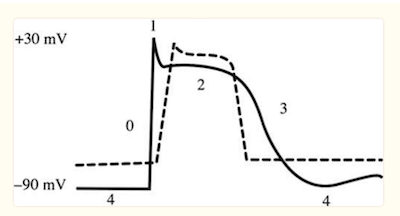Eclampsia
Written by BreAnna McCartan • 2022 Scholar
History

Sophia is a two-year-old intact female, that presented with tremoring and general weakness by not being able to stand properly. The owners thought her limbs felt very stiff and she seemed to not be acting herself. The owner noted that she did have 5, 6-week-old puppies at home that she was still nursing. She as well had not been to a vet since she was a puppy.
Physical Exam Findings
Upon physical examination Sophia was slightly tachycardic and had slightly elevated respirations. Her mucus membranes were light pink but had a normal capillary refill time. Dr. Pottorff noted neurologically that she did have some generalized tremors and reproductively had mammary development. He as well noted dental disease.
Diagnostics
Based on the history and the physical exam findings an ionized blood calcium level was ran.. Based off of “Emergency Procedures for the Small Animal Veterinarian” it is indicated that testing an ionized blood calcium is more accurate in terms of the body’s calcium levels compared to a total calcium. This was ran and came back at 0.5. The normal range is 1.12-1.32.
Diagnosis
Sophia was diagnosed with Eclampsia or otherwise known as milk fever.
About This Disease
According to the sources listed at the bottom of this study, Eclampsia is an acute onset disease that can be life- threatening. It is a result of hypocalcemia that occurs most commonly when small breed dogs have large litters. This disease can however occur in any size dog with any size litter, with a rare occurrence in cats.
Hypocalcemia can occur during or after gestation. At this stage the mothers body demands more calcium for uterine contractions to expel the puppies and/or calcium to make milk to feed the puppies. This calcium is pulled off her bodies stores to meet this high demand, the most common places the body gets calcium from is bone and the diet to be metabolized and used by the body. If the mother is fed an improper diet this disease can develop or if the demand for milk is so high that her body cannot replenish her calcium in time, then the body can become hypocalcemic and eclamptic.
Prognosis
Sophia has a good prognosis since the disease was caught early enough. This disease does require medical intervention to cure and animals can go on to live a normal healthy life when their calcium levels return to normal. This disease can reoccur if the animal becomes pregnant again.
Treatment
Sophia was treated with an injection of Calcium Gluconate intravenously. The dose range for Calcium Gluconate is 0.5 – 1.5 mL/Kg at an injection rate of 1mL/ min. This drug needs to be injected slowly because of the risk of causing reflex bradycardia in patients. Dr. Pottorff explained that he prefers using the higher end of the dose margin for this disease because of his previous experience of dosing to low and having to redoes the patient. Once the symptoms are controlled then the patient can go home with oral calcium carbonate tablets (tums over the counter) at 25-50 mg/kg/day. Lastly the puppies should be weaned immediately and the mother’s diet should be re-assessed to make sure she has the proper nutrition for weaning.
Mechanism Behind Reflex Bradycardia
Bradycardia can occur when Calcium is injected to fast intravenously. The mechanism that causes this lies within the heart muscle. Below is a visual of an action potential that occurs during a muscle contraction. To get a muscle to contract it must have the proper transmembrane potential to create an action potential. An action potential occurs around 65mV. This then causes a reaction where ions like Na+, K+ and Ca+ move either in or out of the cell membrane.
Normally within a cell K+ ions are in higher concentration and Na+ ions are higher outside of the cell. At the start of the action potential the Na+/ K+ ATPase pump causes the movement of ions. At phase 0 on the diagram this is called depolarization where Na+ influxes into the cell to reduce the transmembrane potential or to make it more postive. In phase 1 this is called initial repolarization where K+ channels are opened and K+ effluxes out of the cell. In phase 2 this is called the plateau phase where things are relatively stable. Na+ channels are inactivated and Ca+ channels are opened for Ca+ to influx into the cell. K+ channels are still opened to balance Ca+ coming into the cell at this period. Phase 3 is where Ca+ channels close and K+ channels remain open so that the membrane potential can repolarize (or goes back to a negative state). Stage 4 is where resting membrane potential is restored. When Ca+ is injected intravenously to fast this can flood the blood stream with Ca+ and cause the ratio between K+ and Ca+ to be off during phase 2 of an action potential. This ratio being off causes a slower repolarization which means a longer time to get back to resting membrane potential. This loss of time means the heart can not make the next contraction as fast as it normally would which in turn is what gives you bradycardia.

References & Citations
- CS;, Parham WA;Mehdirad AA;Biermann KM;Fredman. “Hyperkalemia Revisited.” Texas Heart Institute Journal, U.S. National Library of Medicine, 2006, https://pubmed.ncbi.nlm.nih.gov/16572868/.
- Plunkett, Signe J. Emergency Procedures for the Small Animal Veterinarian. Saunders Elsevier, 2013.
- Rothrock DVM, Kari, et al. “Eclampsia .” Vin Login, Vin, 19 Mar. 2014, https://www.vin.com/members/cms/project/defaultadv1.aspx?pid=607&id=6180573.
- Course: BMS 333 Fall of 2021, Lecture #10 By Dr. Troph


